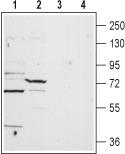Tpcn1 Rabbit Polyclonal Antibody
Other products for "Tpcn1"
Specifications
| Product Data | |
| Applications | IHC, WB |
| Recommended Dilution | WB: 1:200-1:2000; IHC: 1:100-1:3000 |
| Reactivities | Rat |
| Host | Rabbit |
| Clonality | Polyclonal |
| Immunogen | Peptide (C)RNLRQIFQSLPPFMD, corresponding to amino acid residues 221-235 of rat Two Pore Calcium Channel Protein 1. 2nd extracellular loop for Two pore calcium channel protein 1 expressed on the plasma membrane. Luminal for Two pore calcium channel prote |
| Formulation | Lyophilized. Concentration before lyophilization ~0.8mg/ml (lot dependent, please refer to CoA along with shipment for actual concentration). Buffer before lyophilization: Phosphate buffered saline (PBS), pH 7.4, 1% BSA, 0.05% NaN3. |
| Purification | Affinity purified on immobilized antigen. |
| Conjugation | Unconjugated |
| Storage | Store at -20°C as received. |
| Stability | Stable for 12 months from date of receipt. |
| Gene Name | two pore segment channel 1 |
| Database Link | |
| Background | Among various vertebrate species, three genes are known to encode two-pore segment channels (TPCs) termed TPC1-3. Interestingly TPC3 seems to be absent from the genomes of primates and rodents. The primary sequence of these channels indicates the presence of two putative pore-forming repeats. Each repeat contains six transmembrane domains and a pore loop, a structure strikingly reminiscent of many voltage-gated Na+ (Nav) and Ca2+ (Cav) channels. These twelve transmembrane structures are further thought to form functional dimers. Both TPC1 and TPC2 show ubiquitous expression, while that of TPC1 is exceptionally high in spleen, lung, liver, and kidney. Ca2+-mobilizing messengers such as inositol triphosphate, cyclic ADP ribose and nicotinic acid adenosine dinucleotide phosphate (NAADP) are responsible for the intracellular changes in Ca2+ ion concentration. In contrast to the other Ca2+-mobilizing agents, NAADP, the most potent of these Ca2+ releasing molecules increases the cytosolic Ca2+ concentration via Ca2+ channels located on acidic vesicles (endolysosomes). Only quite recently, after almost a decade of being cloned, TPC1 and TPC2 were both found to be responsible for the NAADP-induced release of Ca2+ . Evidence that these two channels are indeed responsible for the release of Ca2+ is quite compelling since overexpression of TPC1 and its knockdown or point mutation of a critical residue increase and exacerbate Ca2+ release respectively. In addition, b-cells from TPC2 knockout mice exhibited no Ca2+ release from endolysosomes upon NAADP stimulation. Finally, in a study using immunopurified channels, it was demonstrated that TPC1 and TPC2 both respond to very low concentrations of NAADP and are unequivocally responsible for the release of Ca2+, whereas TPC3 may negatively regulate the release of Ca2+ . As these channels have only recently been discovered, very little is known about their physiology and gating mechanisms. Their probable involvement in a number of diseases such as lysosomal storage disease (LSDs), caused by the dysfunction of lysosomal associated proteins, has yet to be deciphered. |
| Synonyms | FLJ20612; KIAA1169; TPC1 |
| Reference Data | |
Documents
| Product Manuals |
| FAQs |
{0} Product Review(s)
0 Product Review(s)
Submit review
Be the first one to submit a review
Product Citations
*Delivery time may vary from web posted schedule. Occasional delays may occur due to unforeseen
complexities in the preparation of your product. International customers may expect an additional 1-2 weeks
in shipping.






























































































































































































































































 Germany
Germany
 Japan
Japan
 United Kingdom
United Kingdom
 China
China




